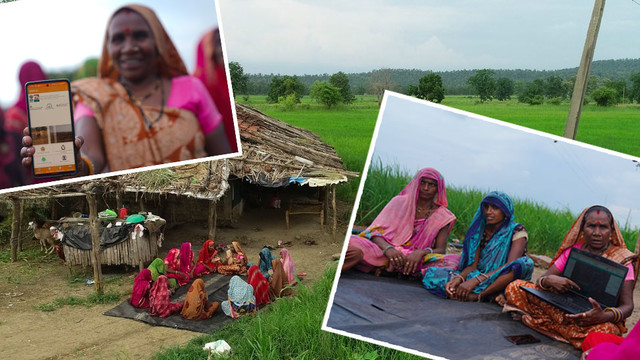How women leaders are getting better social protection for the vulnerable
Ritu Bharadwaj and Daljeet Kaur discuss how women leaders in India are showing the way for enhancing access to social protection and delivering climate resilience at scale.



Women in Dumardih village raising their hands to identify themselves as leaders (Photo: Ritu Bharadwaj, IIED)
Gram Sabha (village assembly) meetings in India have traditionally been male bastions, where women sit quietly to one side and respond with occasional nods to agenda items that require their approval. But this situation has been transformed in Dumardih village in Jharkhand province: here, women proudly identify themselves as community leaders and implement their agenda in Gram Sabha meetings with poise and confidence.
This transformation has been achieved by the PHIA foundation, a grassroots NGO that motivates women to voluntarily nominate themselves as women leaders. PHIA then trains and supports the women, helping them to emerge as women leaders, advance their priorities in local decision-making and contribute to the development and climate-resilience agenda.
What do the women leaders do?
Ensuring vulnerable families can access the social safety net during crisis
The effectiveness of social protection programmes in delivering climate resilience during a crisis depends on benefits reaching the most needy in a timely manner. The women leaders are trained to identify the families most in need and to ensure they have access to social protection entitlements.
The women leaders are mentored by PHIA staff, who guide them on mobilising communities, analysing problems and identifying context-specific solutions. The women learn about social protection programmes, eligibility criteria and entitlements and how to identify and support vulnerable community members.
The women use a range of participatory tools, such as community surveys, risk and vulnerability mapping, and resource and livelihoods mapping, to collectively identify the most vulnerable households. PHIA mentors support them to fill out forms/applications for these households to access social protection entitlements and present them to the Gram Sabha for endorsement.
PHIA mentors also help them take applications to government officials to get them approved. Since the programme started in 2018, the women leaders have established a rapport with the government functionaries and have become confident enough to develop and take these applications to government offices on their own.

Women leaders facilitating a participatory social mapping exercise to identify vulnerable individuals and families (Photo: Ritu Bharadwaj, IIED)
Pressure to weed out corruption
Women leaders have collectively put pressure on government-appointed agents managing the Public Distribution Shops (PDS) that provide subsidised food grains, cooking oil and other items to ensure that they provide the right quantity and quality of supplies to eligible families in a timely manner. It is common for PDS owners to syphon the subsidised grain and sell it on the open market at a higher price.
The women leaders were supported to file complaints about late delivery or poor quality of grains, and they successfully pressured the PDS to stop the illicit outflow of food grain.
Helping the poor and elderly get help and advice
Women leaders play a crucial role in ensuring access to social protection schemes by acting as a 'helpdesk' for marginalised and vulnerable villagers. Village elders and poor villagers seek their help in getting an old-age pension, work under India's MGNREGS social protection scheme, access to health benefits, and so on.
The women help community members, first, by bridging the ‘awareness’ gap: informing them about their eligibility and entitlement; secondly, by giving them a ‘voice’ to raise demands; and thirdly, by ensuring 'last mile' connectivity to the social safety net in times of crisis, such as COVID-19 or drought.
This approach also helps government functionaries get up-to-date data on poor and marginalised households – often absent from government databases – to ensure better coverage of their programmes. Government agencies are also beginning to publicly recognise the value of these grassroots women leaders in enhancing outreach and effective delivery of government programmes.
'Business unusual': how women leaders are transforming decision-making and programme delivery
While the women leaders are improving the delivery of social protection, their empowerment has delivered change in other ways.
Shifting power
By supporting not just their own agenda but helping the poor, marginalised and elderly claim their rights, these women are gradually changing the gender norms of their society. They are now widely acknowledged by the community as being more persistent, persuasive and effective in making government officials respond to village needs.
This has changed the attitudes of the elders and men of the village, who traditionally wanted women confined in homes. They now treat women with respect, accept their authority and recognise the value of bringing women into the mainstream.
Leading differently
These women leaders are more forthcoming than male leaders in sharing information, allowing everyone in the village to understand and benefit from social protection schemes.
The emergence of women's leadership has also helped to develop a more inclusive society and promoted a spirit of self-help in the village. The women operate outside caste and religious divides and help each other during times of need – during weddings, festivals or when a family member falls ill.
Being transformative
The women are gradually creating confidence and inspiring young girls, women and vulnerable people to stand up for their rights and take charge of the issues that matter to them. They are ensuring ‘whole-of-community’ decisions, thereby creating a strong sense of ownership towards village-level development initiatives.
They are increasing the number of women participating, contributing to collective problemsolving and enhancing responsiveness and accountability of the social protection systems.
The journey of these women leaders has not been smooth. They still face barriers due to repressive social and institutional norms, but their efforts are transforming the system and making a difference – even if only at a small scale initially.
Policymakers should take note of this potential and consider using this model to develop grassroots women leaders as delivery agents for social protection – providing guidance and ensuring entitlements reach the most needy and vulnerable at the local level.




